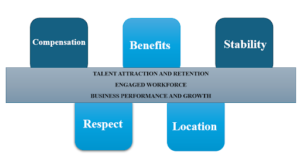In the current competitive work environment capturing and holding on to the best talent is the secret to the businesses success. One such effective tool for the same is a robust Employee Value Proposition (EVP) showcasing the unique rewards and experiences that an organization offers to its employees in exchange for their talent and dedication. This article talks about the essence of a strong EVP, its essential components and ways to create one which is loaded with relevant statistics and case studies.
What is an Employee Value Proposition?
An Employee Value Proposition encompasses the distinct package of offerings and values that an employer has to present to the employees. It comprises the tangible rewards such as remuneration and benefits, as well as the intangible ones such as career development opportunities, work-life balance, company culture, and company mission and values. Essentially, the EVP answers the question: “Why would a highly competent professional wish to work here?

Separating EVP and Employer Brand
While closely related, EVP and employer brand play different roles. EVP is an internal vow, providing a definition of what employees can expect from the organization. On the other hand, the employer brand is the external perception of the company as an employer, guided by the EVP but focused on how the company is seen by potential candidates and the broader public. A well-crafted EVP underpins a successful employer brand, with alignment between internal realities and external messaging. Wikipedia
Benefits of a Strong EVP
Investing in a strong EVP offers several advantages:
-
Attracting and Keeping Top Talent:
A clear and compelling EVP draws individuals whose aspirations and values align with the company, enhancing recruitment and reducing turnover. Gartner
-
Increased Employee Engagement:
Employees who relate to the EVP get engaged, leading to greater productivity and job satisfaction.
-
Cost Savings:
Firms can reduce recruitment and training expenses by saving turnover and hiring correct talent.
-
Better Organizational Performance:
Dedicated employees fuel better performance and competitive edge in the market.
EVP Important Aspects
A good EVP would generally include the following aspects:
| Component | Description |
| Compensation | Includes salary, bonuses, and additional financial rewards. |
| Work-Life Balance | Involves flexible working hours, remote work options, paid time off, and policies that support employees in balancing professional and personal responsibilities. |
| Stability | Refers to the job security, consistent work schedules, and opportunities for career development within the organization. |
| Location | Refers to the physical work environment, ease of commute, and the overall atmosphere of the workplace. With remote work, this also includes virtual work settings. |
| Respect | Involves fostering a culture of mutual respect, recognition, inclusivity, and support among colleagues and management. |
Developing and Enhancing Your EVP
To create a compelling EVP:
Recognize Organizational Distinctiveness: Recognize the key differences in culture, opportunity, and rewards that make your company stand apart.
Be Knowledgeable of Employee Needs: Carry out employee surveys and feedback forums with current staff to be informed about the needs that most resonate with employees.
Assure Alignment to Company Mission and Values: Ensure that the EVP speaks to and is aligned with the organization’s fundamental values and strategic objectives.
Communicate with Authenticity: Be truthful and transparent while conveying the EVP so that aspirations are met by what is available.
Review and Revision on a Periodic Basis: Regularly review and enhance the EVP to stay significant and attuned to changing employee aspirations and competitive marketplace forces.
Examples of Fantastic EVPs in the Real World
| Company | EVP Highlights |
| Deloitte | Prioritizes personal growth, meaning, and belonging. Offers competitive compensation, clear performance distinctions, and a reward system grounded in corporate values. |
| Patagonia | Prioritizes environmental stewardship and social justice. Gives employees the chance to support environmental activism and provides them with a sense of purpose and impact. |
| HubSpot | Prioritizes flexibility and independence, with unlimited time off, home working options, and outcome-driven instead of hours-driven working. |
| Salesforce | Prioritizing trust, customer success, innovation, and equity. Provides full-benefits job coverage, regular education opportunities, and diversity and inclusion emphasis. |
| Unilever | Features a purpose-driven culture with sustainability and social responsibility prioritization. Provides varied career prospects and prioritizes employee well-being. |
Conclusion
A defined and communicated employee value proposition is the winning hand that attracts, engages, and retains talent. By clearly stating what it is about your company that differs from others in terms of benefits and values, you’re not only establishing your employer brand, but you’re also recruiting a loyal and high-performing workforce that’s prepared to drive sustained success.





